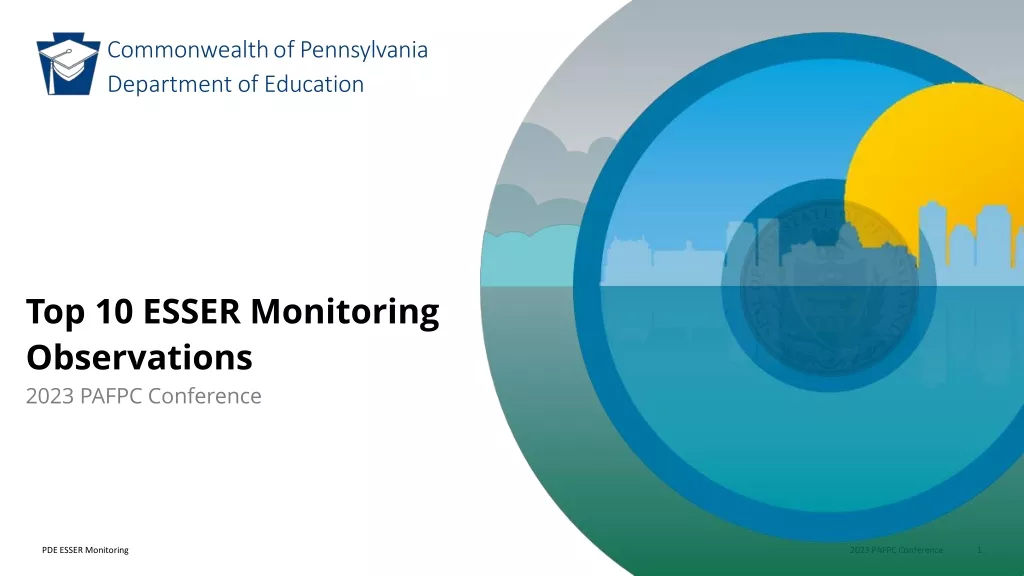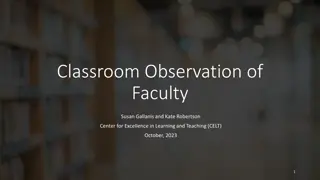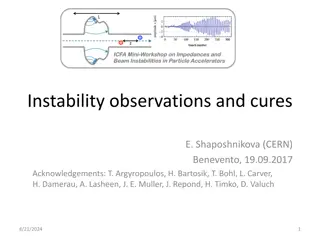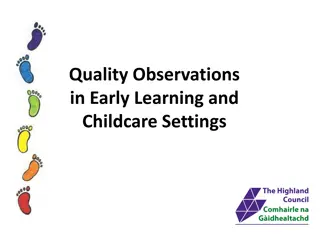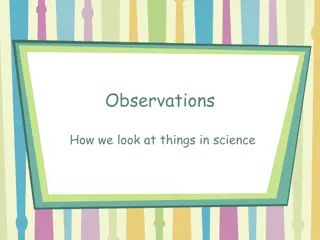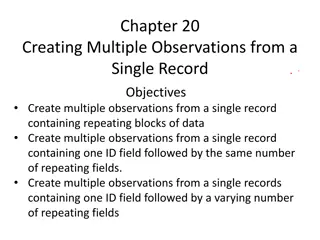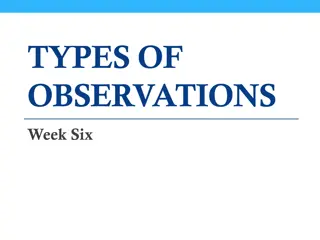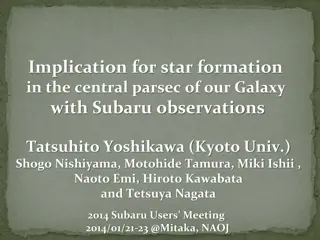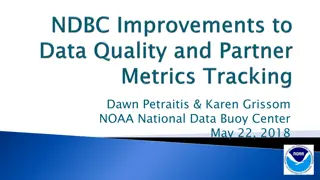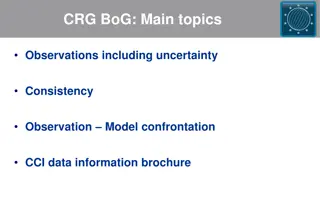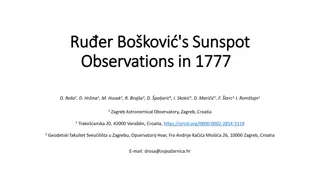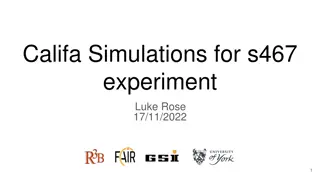
Understanding Observational Methods in Research
Explore different types of observational methods, such as participant and non-participant observations, covert and overt observations. Learn about the strengths and limitations associated with each method and their application in various research settings.
Download Presentation

Please find below an Image/Link to download the presentation.
The content on the website is provided AS IS for your information and personal use only. It may not be sold, licensed, or shared on other websites without obtaining consent from the author. If you encounter any issues during the download, it is possible that the publisher has removed the file from their server.
You are allowed to download the files provided on this website for personal or commercial use, subject to the condition that they are used lawfully. All files are the property of their respective owners.
The content on the website is provided AS IS for your information and personal use only. It may not be sold, licensed, or shared on other websites without obtaining consent from the author.
E N D
Presentation Transcript
RECAP TAKE A WHITEBOARD Draw the following table and fill it in: Type of interview Structured Strengths Weaknesses Unstructured Semi-structured Group
Research Methods Lesson 5 Research Methods Observations Objectives: Know the different types of observational methods Be able to explain the main stages in conducting a participant observation study Be able to evaluate the strengths and limitations of overt and covert participant observation Be able to apply your understanding of observational methods to the study of education
Lesson Objectives To describe participant and non participant observations To describe covert and overt observations To explain the strengths and limitations associated with each
Task Page 23 What s the difference between the observations on page 23 Think about whether the researcher is taking part in the research or not Would interpretivists or positivists prefer observations?
Observation There are several types Non participant Researcher simply observes the group Participant The researcher actually takes part in the event whilst observing it Overt Researcher makes their identity known and is open about what they are doing Covert Under cover. Researcher takes on a false identity/role and poses as a genuine member of the group However, research doesn t always fit neatly in to these categories
So What do you think the problems might be with covert observations? What do you think may be good about them?
What would you use for Observing interactions between mothers and babies in their home Investigating criminal gangs Observing a lesson within a school class
Conducting a participant observation study Researcher takes part in an event or the every day life of a group while observing it. There are two main issues: 1. Getting in, staying in and getting out of the group being studied 2. Whether to use overt or covert observation
Getting in The researcher needs to first, gain entry to the group Some groups may be easier to enter e.g. joining a football crowd vs. a criminal gang
Getting in Making contact - Good personal skills are needed - You may need to know someone in the group or have connections - E.g. being in hospital due to a broken leg and being able to study how you get treated as a patient
Getting in acceptance Based on trust/acceptance May help to make friends with a key individual An extreme example Griffin was a white man who in 1959 used medication and sun lamps to turn his skin colour and pass as black He was then able to see the impact of white racism
Staying in Once accepted the researcher needs to be able to stay in the group to complete the study It is difficult to be in a group, understand it fully and be an objective observer and be a member of the group! What problems could this cause?
Staying in going native Becoming over involved, leading to the researcher becoming biased Researchers may also want to remain detached so they may not understand the events the are observing. More time the researcher spends with the groups, the less strange the behaviour becomes The researcher may fail to notice certain things that once struck them as unusual. I started as a non-participating observer and ended as a non-observing participator
Getting out Make notes on getting out on page 139 Make sure you understand the difficulties of getting out How it can affect validity of data
Distinguishing between the different types of observation . Complete the advantages of participant observation using page 140 of the textbook (page 25 of your booklet) Write which part of PERVERT it applies to e.g. validity, representativeness etc.
Advantages of participant observation Validity observing people can provide rich qualitative data that provides a picture of how they really live this is the main strength for participant observation Insight best way to truly understand is to experience it for ourselves and to put yourself in another person s place Participant observation enables the researcher to gain empathy through personal experience.
Advantages of participant observation Observations are flexible, researcher can switch and change things Allows the researcher to discover things that other methods may miss Practical Groups may be suspicious if outsiders who ask questions Participant observation enables the sociologist to build a report with the group and gain trust Can be used in situations where questioning would be ineffective.
Reliability/validity in participant observation Positivists critical of participant observation, rarely quantified and unreliable Very difficult to replicate Positivists criticise interpretivists because how can you prove they have interpreted the attitudes and experiences of others correctly.
Non-participant Strengths weaknesses Reduces the risk that people will be affected by the presence of a researcher or member of their social group Can be used when groups may be unwilling to cooperate in research (although this can raise ethical issues) Allows researchers to observe people in their normal social situations and avoid the Hawthorne effect The Hawthorne effect is a type of reactivity in which individuals modify or improve an aspect of their behaviour in response to their awareness of being observed. Doesn t allow the researcher to investigate the meanings people attach to the behaviour that is being observed The data may well reflect the assumptions and interpretations of the researcher, raising serious issues over reliability and validity of the data.
Observation There are several types Non participant Researcher simply observes the group Participant The researcher actually takes part in the event whilst observing it Overt Researcher makes their identity known and is open about what they are doing Covert Under cover. Researcher takes on a false identity/role and poses as a genuine member of the group
Overt observations Most sociologists favour overt Complete the disadvantages of overt observations (pg. 139)
Disadvantages of overt observations Group may refuse the researcher permission form observing or seeing everything Risks creating Hawthorne effect (behave differently)
Covert observations Strengths gain first-hand knowledge of the group being studied best way to discover meanings by seeing through the eyes of members of the group People can be studied in their normal social situation over a period of time, rather than in the artificial and snapshot context of a questionnaire or interview
Covert observations Limitations Practical problems: Requires researcher to keep up an act, there is the risk of the researcher s cover being blown Researcher can t take notes openly and must rely on memory and opportunity to write them in secret, questioning validity Ethical issues: Serious ethical issues for researchers Immoral to deceive people Covert observers may need to lie about their reasons for leaving the group May have to participate in immoral or illegal activities as part of their cover role
Yes or No? Overt observations are more ethical than covert observations.
Yes or No? Covert observations enables participants to act more naturally
Yes or No? The sample sizes during observations are usually small
Yes or No? Participant observations produce qualitative data
Check your understanding 1. Explain the difference between overt and covert observation 2. Suggest two reasons why it might be difficult for the observer to gain the trust of a group they wish to study 3. Why do critics argue that participant observation studies lack objectivity? 4. Why does participant observation produce valid data? 5. Why do some critics argue that participant observation does not produce valid data?
Check your understanding answers 1. Overt: the researcher makes their true identity and purpose known to those being studied. Covert: the researcher s real identity and purpose are kept concealed from the group. 2. Differences of age/gender/class/ethnicity between researcher and group; observer may be seen as a representative of authority by deviant/secretive groups; group may suspect researcher s motives (e.g. to sell a sensationalised story to the media); in covert PO, researcher not knowing group s norms of behaviour.
Check your understanding answers There is a risk of the observer becoming too involved/ going native and presenting a biased view of the group. Loyalty to the group or fear of reprisals may lead the observer to conceal sensitive information. PO often attracts sociologists who sympathise with the underdog. But telling it like it is from the actor s point of view may result in bias in favour of their subjects viewpoint. By allowing the sociologist to become an insider, it produces an authentic account of the actor s world. It avoids imposing the sociologist s own categories and ideas on the facts. The findings of PO may be merely the observer s subjective/biased impressions. The researcher selects what facts they think are worth recording, and these are likely to fit in with their pre-existing views. The observer s presence may make the subjects act differently, defeating the aim of producing a naturalistic account of human behaviour. 3. 4. 5.


